Developing Teaching Techniques for Children: An Australian Perspective
VerifiedAdded on 2020/04/15
|18
|2903
|261
Essay
AI Summary
This essay delves into the crucial role of early childhood education in Australia, emphasizing the importance of the Australian Curriculum in shaping young children's development. It highlights the significance of incorporating humanities subjects like History, Geography, Civics, and Citizenship to foster a deeper understanding of the world, culture, and community. The essay provides an overview of the curriculum and its importance, emphasizing how children learn through observation and engagement. It then outlines practical ways to use resources to enhance children's learning across different age groups (0-2, 3-5, and 6-8 years), offering specific examples and activities related to civics, history, and geography. The conclusion underscores the vital role of humanities and social sciences in early childhood education for overall child development.
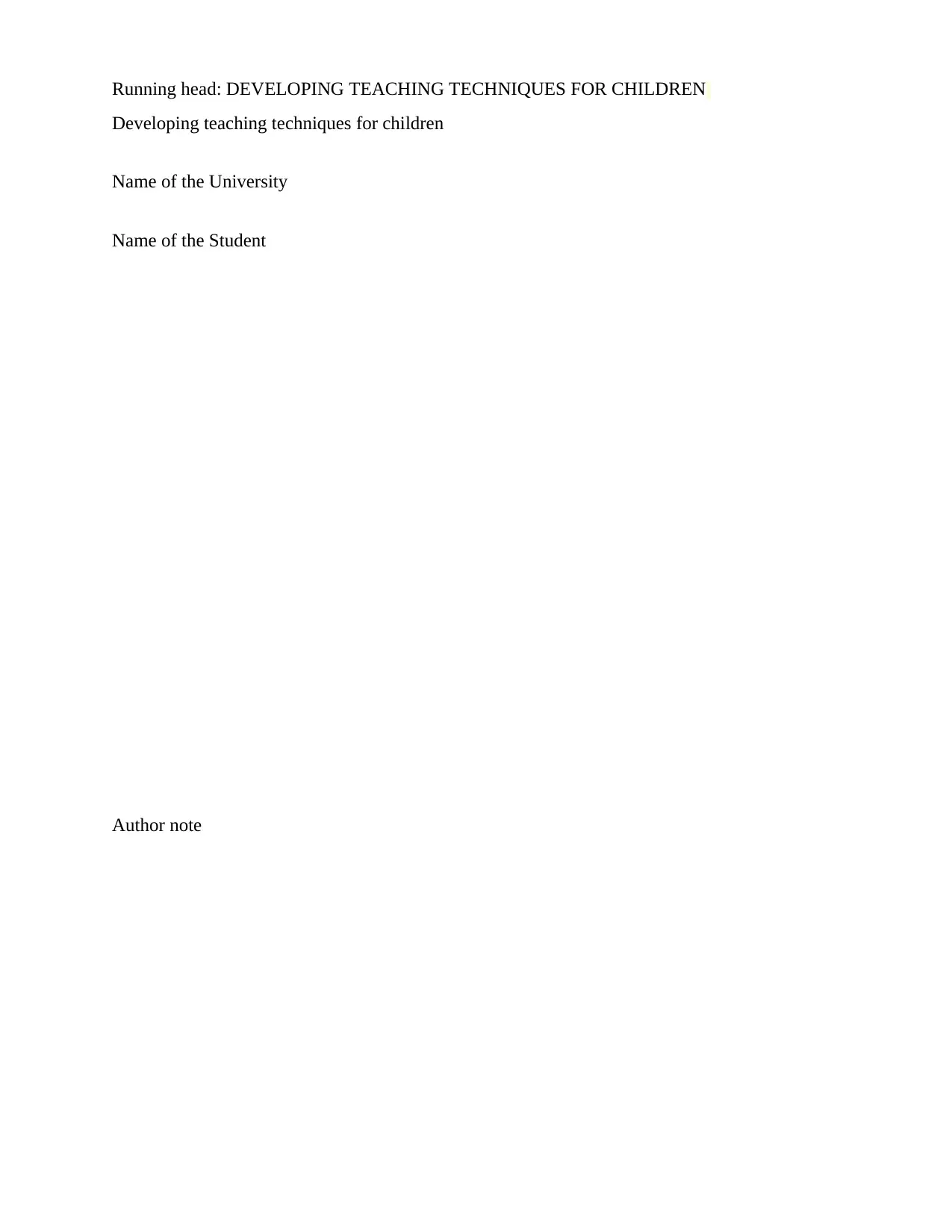
Running head: DEVELOPING TEACHING TECHNIQUES FOR CHILDREN
Developing teaching techniques for children
Name of the University
Name of the Student
Author note
Developing teaching techniques for children
Name of the University
Name of the Student
Author note
Paraphrase This Document
Need a fresh take? Get an instant paraphrase of this document with our AI Paraphraser
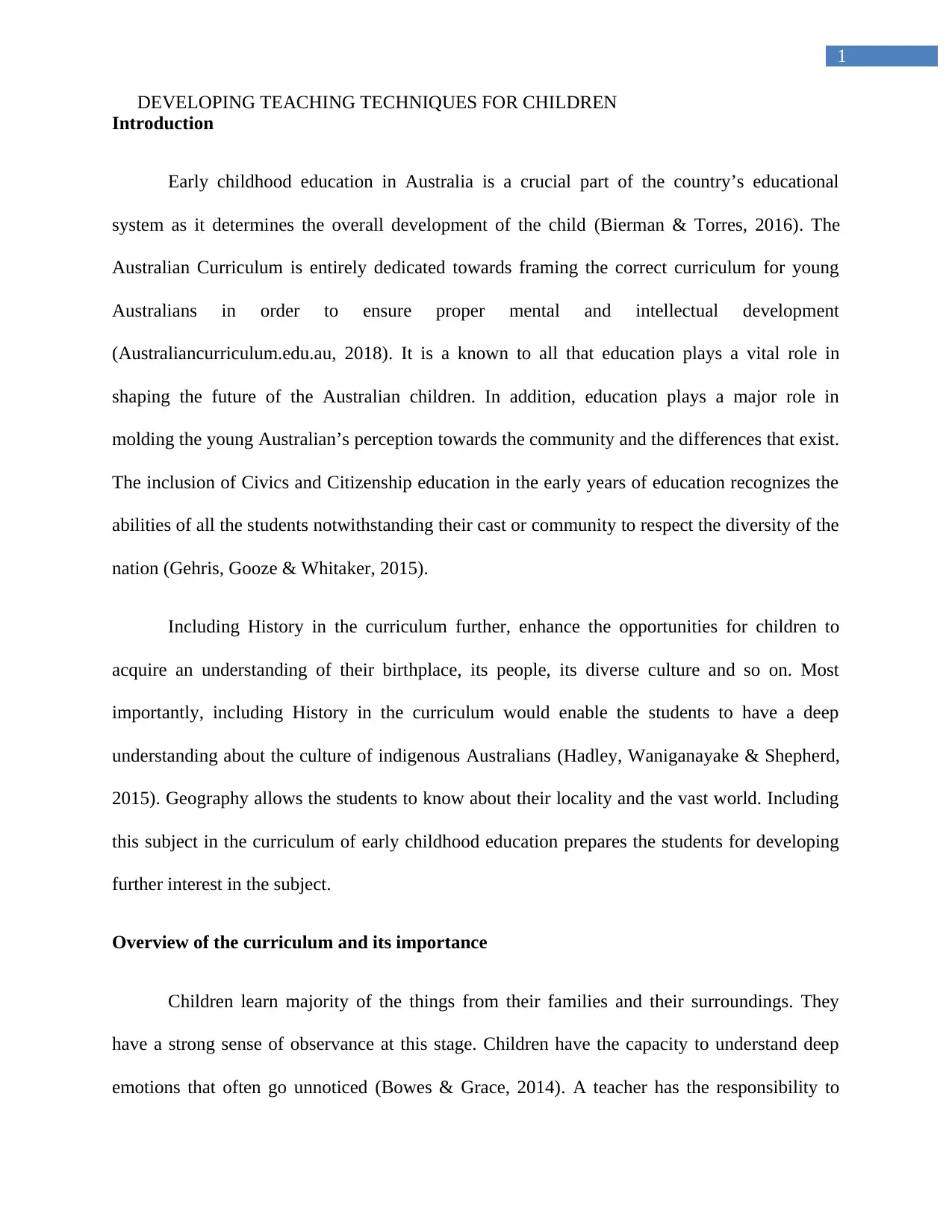
1
DEVELOPING TEACHING TECHNIQUES FOR CHILDREN
Introduction
Early childhood education in Australia is a crucial part of the country’s educational
system as it determines the overall development of the child (Bierman & Torres, 2016). The
Australian Curriculum is entirely dedicated towards framing the correct curriculum for young
Australians in order to ensure proper mental and intellectual development
(Australiancurriculum.edu.au, 2018). It is a known to all that education plays a vital role in
shaping the future of the Australian children. In addition, education plays a major role in
molding the young Australian’s perception towards the community and the differences that exist.
The inclusion of Civics and Citizenship education in the early years of education recognizes the
abilities of all the students notwithstanding their cast or community to respect the diversity of the
nation (Gehris, Gooze & Whitaker, 2015).
Including History in the curriculum further, enhance the opportunities for children to
acquire an understanding of their birthplace, its people, its diverse culture and so on. Most
importantly, including History in the curriculum would enable the students to have a deep
understanding about the culture of indigenous Australians (Hadley, Waniganayake & Shepherd,
2015). Geography allows the students to know about their locality and the vast world. Including
this subject in the curriculum of early childhood education prepares the students for developing
further interest in the subject.
Overview of the curriculum and its importance
Children learn majority of the things from their families and their surroundings. They
have a strong sense of observance at this stage. Children have the capacity to understand deep
emotions that often go unnoticed (Bowes & Grace, 2014). A teacher has the responsibility to
DEVELOPING TEACHING TECHNIQUES FOR CHILDREN
Introduction
Early childhood education in Australia is a crucial part of the country’s educational
system as it determines the overall development of the child (Bierman & Torres, 2016). The
Australian Curriculum is entirely dedicated towards framing the correct curriculum for young
Australians in order to ensure proper mental and intellectual development
(Australiancurriculum.edu.au, 2018). It is a known to all that education plays a vital role in
shaping the future of the Australian children. In addition, education plays a major role in
molding the young Australian’s perception towards the community and the differences that exist.
The inclusion of Civics and Citizenship education in the early years of education recognizes the
abilities of all the students notwithstanding their cast or community to respect the diversity of the
nation (Gehris, Gooze & Whitaker, 2015).
Including History in the curriculum further, enhance the opportunities for children to
acquire an understanding of their birthplace, its people, its diverse culture and so on. Most
importantly, including History in the curriculum would enable the students to have a deep
understanding about the culture of indigenous Australians (Hadley, Waniganayake & Shepherd,
2015). Geography allows the students to know about their locality and the vast world. Including
this subject in the curriculum of early childhood education prepares the students for developing
further interest in the subject.
Overview of the curriculum and its importance
Children learn majority of the things from their families and their surroundings. They
have a strong sense of observance at this stage. Children have the capacity to understand deep
emotions that often go unnoticed (Bowes & Grace, 2014). A teacher has the responsibility to
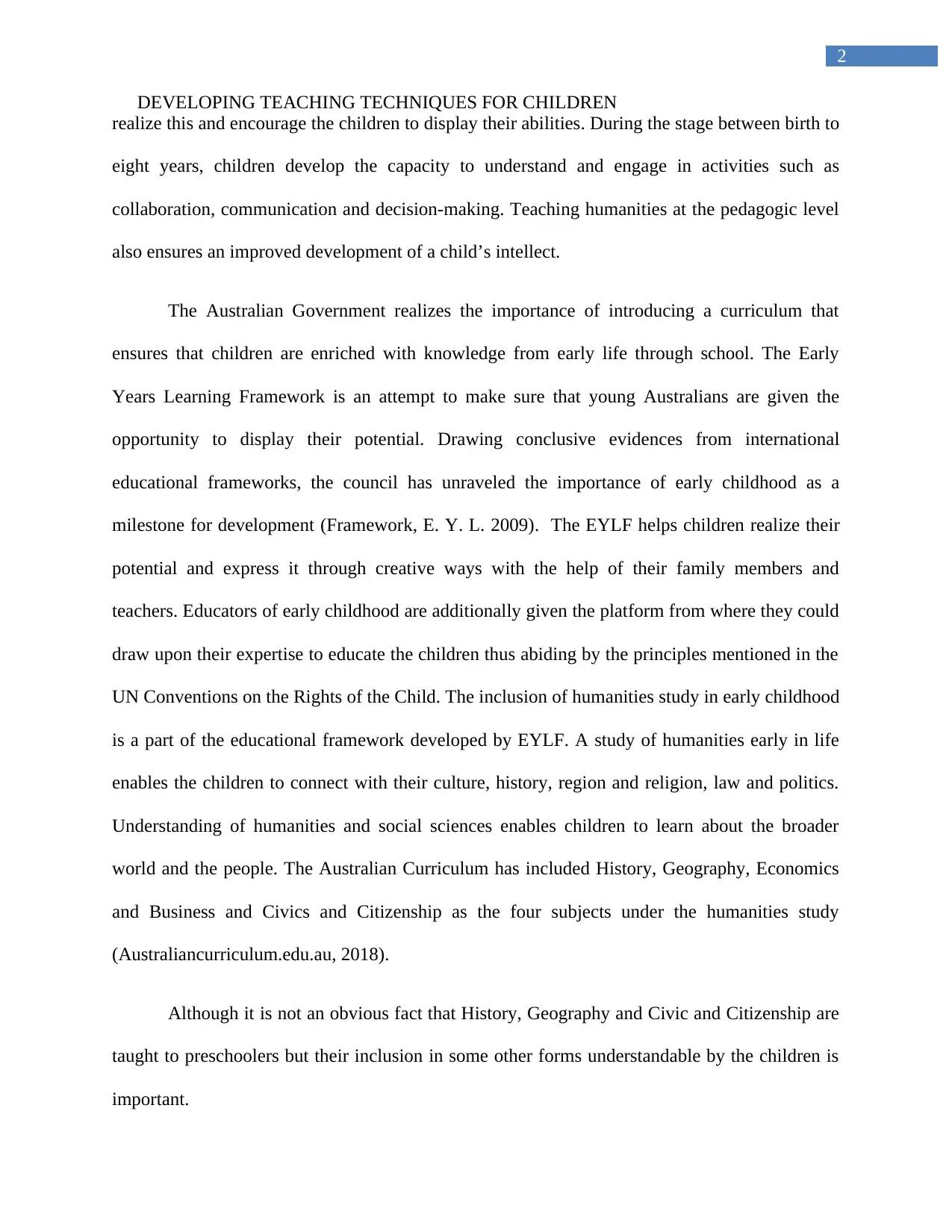
2
DEVELOPING TEACHING TECHNIQUES FOR CHILDREN
realize this and encourage the children to display their abilities. During the stage between birth to
eight years, children develop the capacity to understand and engage in activities such as
collaboration, communication and decision-making. Teaching humanities at the pedagogic level
also ensures an improved development of a child’s intellect.
The Australian Government realizes the importance of introducing a curriculum that
ensures that children are enriched with knowledge from early life through school. The Early
Years Learning Framework is an attempt to make sure that young Australians are given the
opportunity to display their potential. Drawing conclusive evidences from international
educational frameworks, the council has unraveled the importance of early childhood as a
milestone for development (Framework, E. Y. L. 2009). The EYLF helps children realize their
potential and express it through creative ways with the help of their family members and
teachers. Educators of early childhood are additionally given the platform from where they could
draw upon their expertise to educate the children thus abiding by the principles mentioned in the
UN Conventions on the Rights of the Child. The inclusion of humanities study in early childhood
is a part of the educational framework developed by EYLF. A study of humanities early in life
enables the children to connect with their culture, history, region and religion, law and politics.
Understanding of humanities and social sciences enables children to learn about the broader
world and the people. The Australian Curriculum has included History, Geography, Economics
and Business and Civics and Citizenship as the four subjects under the humanities study
(Australiancurriculum.edu.au, 2018).
Although it is not an obvious fact that History, Geography and Civic and Citizenship are
taught to preschoolers but their inclusion in some other forms understandable by the children is
important.
DEVELOPING TEACHING TECHNIQUES FOR CHILDREN
realize this and encourage the children to display their abilities. During the stage between birth to
eight years, children develop the capacity to understand and engage in activities such as
collaboration, communication and decision-making. Teaching humanities at the pedagogic level
also ensures an improved development of a child’s intellect.
The Australian Government realizes the importance of introducing a curriculum that
ensures that children are enriched with knowledge from early life through school. The Early
Years Learning Framework is an attempt to make sure that young Australians are given the
opportunity to display their potential. Drawing conclusive evidences from international
educational frameworks, the council has unraveled the importance of early childhood as a
milestone for development (Framework, E. Y. L. 2009). The EYLF helps children realize their
potential and express it through creative ways with the help of their family members and
teachers. Educators of early childhood are additionally given the platform from where they could
draw upon their expertise to educate the children thus abiding by the principles mentioned in the
UN Conventions on the Rights of the Child. The inclusion of humanities study in early childhood
is a part of the educational framework developed by EYLF. A study of humanities early in life
enables the children to connect with their culture, history, region and religion, law and politics.
Understanding of humanities and social sciences enables children to learn about the broader
world and the people. The Australian Curriculum has included History, Geography, Economics
and Business and Civics and Citizenship as the four subjects under the humanities study
(Australiancurriculum.edu.au, 2018).
Although it is not an obvious fact that History, Geography and Civic and Citizenship are
taught to preschoolers but their inclusion in some other forms understandable by the children is
important.
⊘ This is a preview!⊘
Do you want full access?
Subscribe today to unlock all pages.

Trusted by 1+ million students worldwide
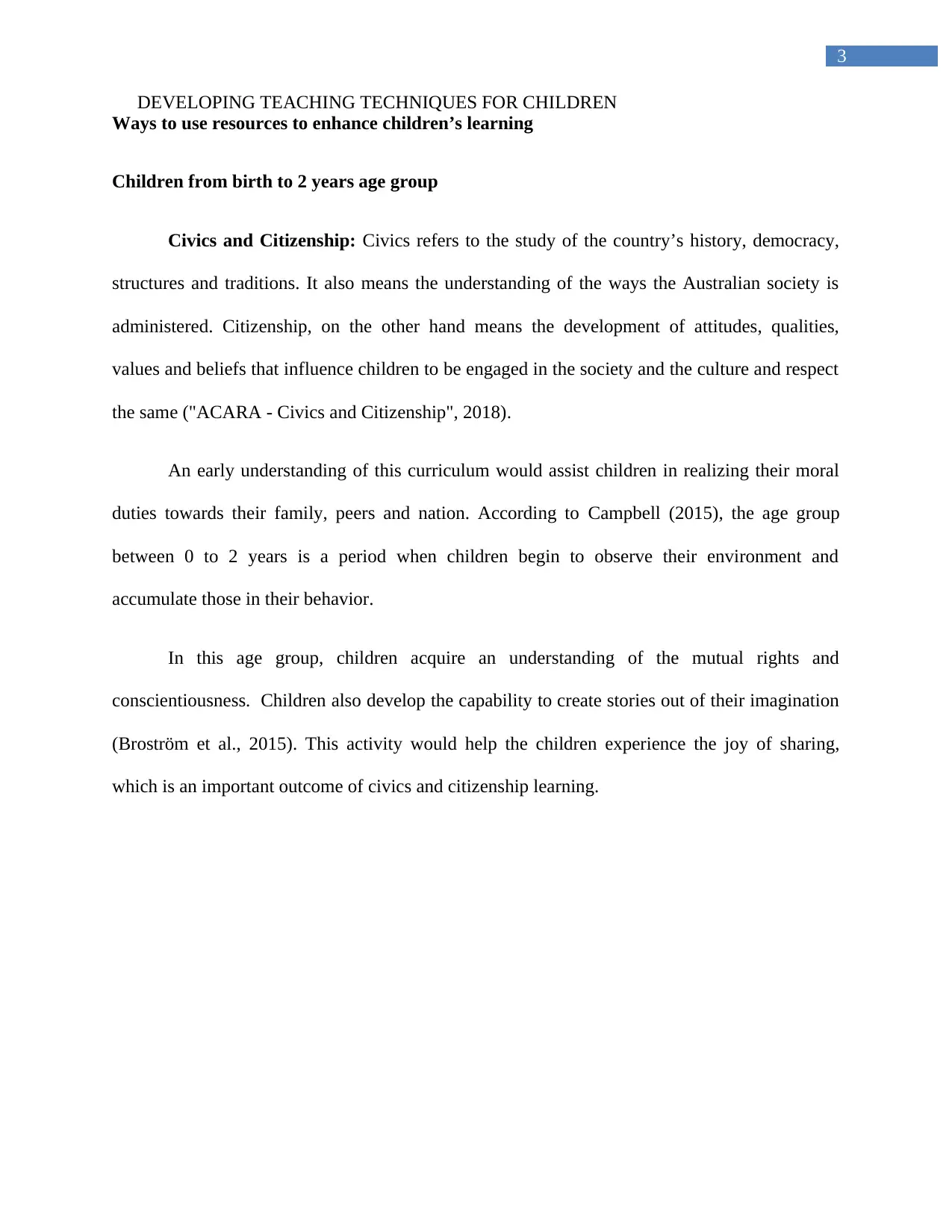
3
DEVELOPING TEACHING TECHNIQUES FOR CHILDREN
Ways to use resources to enhance children’s learning
Children from birth to 2 years age group
Civics and Citizenship: Civics refers to the study of the country’s history, democracy,
structures and traditions. It also means the understanding of the ways the Australian society is
administered. Citizenship, on the other hand means the development of attitudes, qualities,
values and beliefs that influence children to be engaged in the society and the culture and respect
the same ("ACARA - Civics and Citizenship", 2018).
An early understanding of this curriculum would assist children in realizing their moral
duties towards their family, peers and nation. According to Campbell (2015), the age group
between 0 to 2 years is a period when children begin to observe their environment and
accumulate those in their behavior.
In this age group, children acquire an understanding of the mutual rights and
conscientiousness. Children also develop the capability to create stories out of their imagination
(Broström et al., 2015). This activity would help the children experience the joy of sharing,
which is an important outcome of civics and citizenship learning.
DEVELOPING TEACHING TECHNIQUES FOR CHILDREN
Ways to use resources to enhance children’s learning
Children from birth to 2 years age group
Civics and Citizenship: Civics refers to the study of the country’s history, democracy,
structures and traditions. It also means the understanding of the ways the Australian society is
administered. Citizenship, on the other hand means the development of attitudes, qualities,
values and beliefs that influence children to be engaged in the society and the culture and respect
the same ("ACARA - Civics and Citizenship", 2018).
An early understanding of this curriculum would assist children in realizing their moral
duties towards their family, peers and nation. According to Campbell (2015), the age group
between 0 to 2 years is a period when children begin to observe their environment and
accumulate those in their behavior.
In this age group, children acquire an understanding of the mutual rights and
conscientiousness. Children also develop the capability to create stories out of their imagination
(Broström et al., 2015). This activity would help the children experience the joy of sharing,
which is an important outcome of civics and citizenship learning.
Paraphrase This Document
Need a fresh take? Get an instant paraphrase of this document with our AI Paraphraser
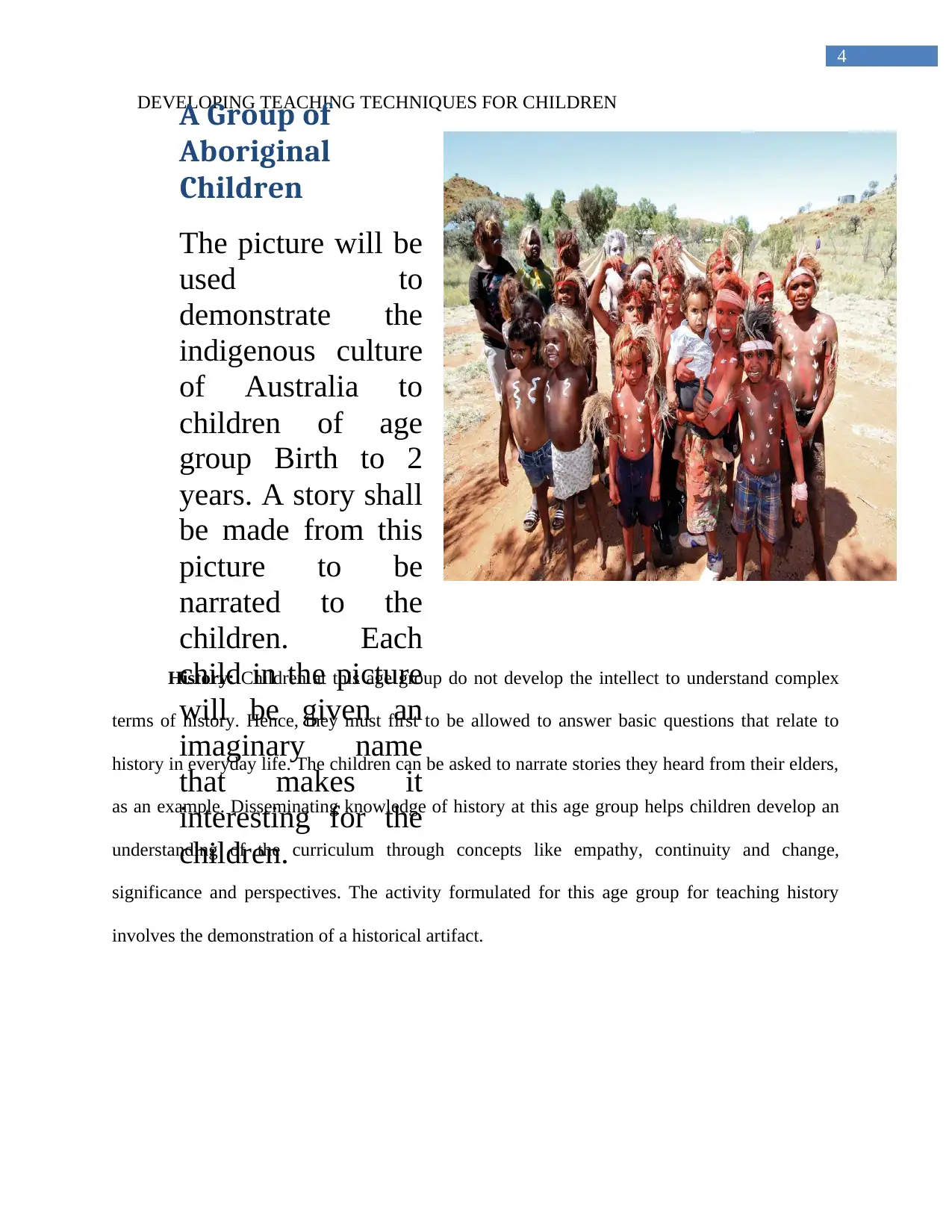
4
DEVELOPING TEACHING TECHNIQUES FOR CHILDREN
History: Children at this age group do not develop the intellect to understand complex
terms of history. Hence, they must first to be allowed to answer basic questions that relate to
history in everyday life. The children can be asked to narrate stories they heard from their elders,
as an example. Disseminating knowledge of history at this age group helps children develop an
understanding of the curriculum through concepts like empathy, continuity and change,
significance and perspectives. The activity formulated for this age group for teaching history
involves the demonstration of a historical artifact.
A Group of
Aboriginal
Children
The picture will be
used to
demonstrate the
indigenous culture
of Australia to
children of age
group Birth to 2
years. A story shall
be made from this
picture to be
narrated to the
children. Each
child in the picture
will be given an
imaginary name
that makes it
interesting for the
children.
DEVELOPING TEACHING TECHNIQUES FOR CHILDREN
History: Children at this age group do not develop the intellect to understand complex
terms of history. Hence, they must first to be allowed to answer basic questions that relate to
history in everyday life. The children can be asked to narrate stories they heard from their elders,
as an example. Disseminating knowledge of history at this age group helps children develop an
understanding of the curriculum through concepts like empathy, continuity and change,
significance and perspectives. The activity formulated for this age group for teaching history
involves the demonstration of a historical artifact.
A Group of
Aboriginal
Children
The picture will be
used to
demonstrate the
indigenous culture
of Australia to
children of age
group Birth to 2
years. A story shall
be made from this
picture to be
narrated to the
children. Each
child in the picture
will be given an
imaginary name
that makes it
interesting for the
children.
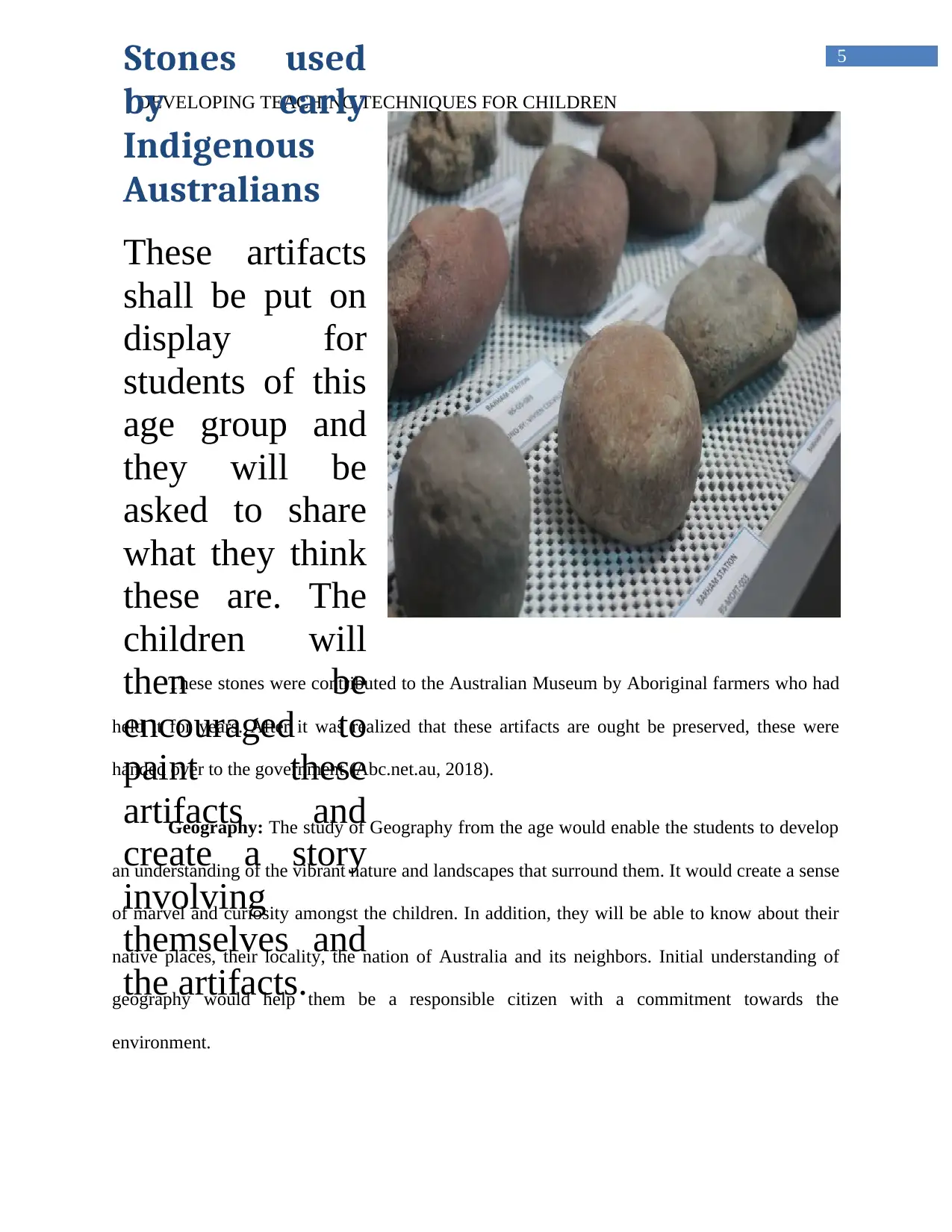
5
DEVELOPING TEACHING TECHNIQUES FOR CHILDREN
These stones were contributed to the Australian Museum by Aboriginal farmers who had
held it for years. After it was realized that these artifacts are ought be preserved, these were
handed over to the government (Abc.net.au, 2018).
Geography: The study of Geography from the age would enable the students to develop
an understanding of the vibrant nature and landscapes that surround them. It would create a sense
of marvel and curiosity amongst the children. In addition, they will be able to know about their
native places, their locality, the nation of Australia and its neighbors. Initial understanding of
geography would help them be a responsible citizen with a commitment towards the
environment.
Stones used
by early
Indigenous
Australians
These artifacts
shall be put on
display for
students of this
age group and
they will be
asked to share
what they think
these are. The
children will
then be
encouraged to
paint these
artifacts and
create a story
involving
themselves and
the artifacts.
DEVELOPING TEACHING TECHNIQUES FOR CHILDREN
These stones were contributed to the Australian Museum by Aboriginal farmers who had
held it for years. After it was realized that these artifacts are ought be preserved, these were
handed over to the government (Abc.net.au, 2018).
Geography: The study of Geography from the age would enable the students to develop
an understanding of the vibrant nature and landscapes that surround them. It would create a sense
of marvel and curiosity amongst the children. In addition, they will be able to know about their
native places, their locality, the nation of Australia and its neighbors. Initial understanding of
geography would help them be a responsible citizen with a commitment towards the
environment.
Stones used
by early
Indigenous
Australians
These artifacts
shall be put on
display for
students of this
age group and
they will be
asked to share
what they think
these are. The
children will
then be
encouraged to
paint these
artifacts and
create a story
involving
themselves and
the artifacts.
⊘ This is a preview!⊘
Do you want full access?
Subscribe today to unlock all pages.

Trusted by 1+ million students worldwide

6
DEVELOPING TEACHING TECHNIQUES FOR CHILDREN
Children from 3 to 5 years age group
Civics and Citizenship: This age group is characterized by children beginning to expand
their world and making new friends. Their communicative powers develop at this stage. In
addition, their emotional development also enhances in this stage. Therefore, engaging them in
the activity that involves doing something for others would elevate their sense of citizenship.
An animated
image of
Australia’s
famous
animal
In this activity, the
children of the age
group will be asked
to describe whatever
they see in the
picture. After that,
they will be asked
whether they have
seen kangaroos in
real life. In addition,
they will be asked to
notice what else they
see in the picture
other than
kangaroos. A
dummy kangaroo
shall be placed in
front of the students
and its pouch shall
have items that
relate to Australia’s
geography.
DEVELOPING TEACHING TECHNIQUES FOR CHILDREN
Children from 3 to 5 years age group
Civics and Citizenship: This age group is characterized by children beginning to expand
their world and making new friends. Their communicative powers develop at this stage. In
addition, their emotional development also enhances in this stage. Therefore, engaging them in
the activity that involves doing something for others would elevate their sense of citizenship.
An animated
image of
Australia’s
famous
animal
In this activity, the
children of the age
group will be asked
to describe whatever
they see in the
picture. After that,
they will be asked
whether they have
seen kangaroos in
real life. In addition,
they will be asked to
notice what else they
see in the picture
other than
kangaroos. A
dummy kangaroo
shall be placed in
front of the students
and its pouch shall
have items that
relate to Australia’s
geography.
Paraphrase This Document
Need a fresh take? Get an instant paraphrase of this document with our AI Paraphraser

7
DEVELOPING TEACHING TECHNIQUES FOR CHILDREN
History: Children at this age group are aware of their pasts that relate to their families
and schools mostly. They have a strong sense of time, as they are able to visualize stories from
the past in fascinating ways. Creatures from the past like Dinosaurs have always been a
fascination for children. However, it is also true that anything that has a historical touch in it
attract children’s fascination. The activity for this age group thus involves a visit to the museum.
The children will be allowed to see different items from the past that define Australian history.
The activity would enable the children to learn about the history of Australia and the life
of Aboriginal people.
Teacher
observes as
children watch
pictures
Children belonging
to this age group
will be asked to
draw pictures,
create greeting
cards for children
whom they will
visit in the coming
days. Children will
first be given cards
and crafts made by
other children from
different
community. They
will be encouraged
to send a token of
gratitude through
greeting cards.
DEVELOPING TEACHING TECHNIQUES FOR CHILDREN
History: Children at this age group are aware of their pasts that relate to their families
and schools mostly. They have a strong sense of time, as they are able to visualize stories from
the past in fascinating ways. Creatures from the past like Dinosaurs have always been a
fascination for children. However, it is also true that anything that has a historical touch in it
attract children’s fascination. The activity for this age group thus involves a visit to the museum.
The children will be allowed to see different items from the past that define Australian history.
The activity would enable the children to learn about the history of Australia and the life
of Aboriginal people.
Teacher
observes as
children watch
pictures
Children belonging
to this age group
will be asked to
draw pictures,
create greeting
cards for children
whom they will
visit in the coming
days. Children will
first be given cards
and crafts made by
other children from
different
community. They
will be encouraged
to send a token of
gratitude through
greeting cards.
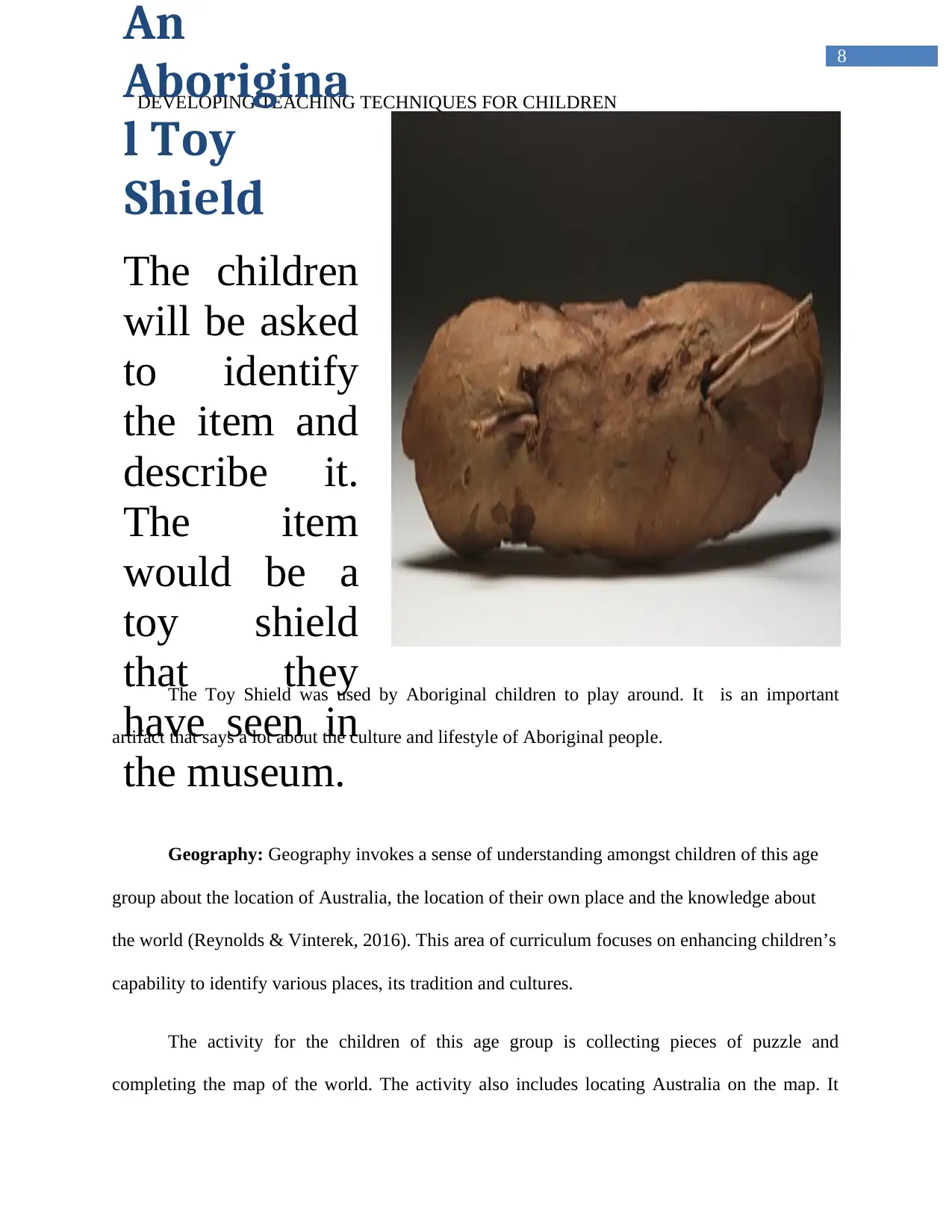
8
DEVELOPING TEACHING TECHNIQUES FOR CHILDREN
The Toy Shield was used by Aboriginal children to play around. It is an important
artifact that says a lot about the culture and lifestyle of Aboriginal people.
Geography: Geography invokes a sense of understanding amongst children of this age
group about the location of Australia, the location of their own place and the knowledge about
the world (Reynolds & Vinterek, 2016). This area of curriculum focuses on enhancing children’s
capability to identify various places, its tradition and cultures.
The activity for the children of this age group is collecting pieces of puzzle and
completing the map of the world. The activity also includes locating Australia on the map. It
An
Aborigina
l Toy
Shield
The children
will be asked
to identify
the item and
describe it.
The item
would be a
toy shield
that they
have seen in
the museum.
DEVELOPING TEACHING TECHNIQUES FOR CHILDREN
The Toy Shield was used by Aboriginal children to play around. It is an important
artifact that says a lot about the culture and lifestyle of Aboriginal people.
Geography: Geography invokes a sense of understanding amongst children of this age
group about the location of Australia, the location of their own place and the knowledge about
the world (Reynolds & Vinterek, 2016). This area of curriculum focuses on enhancing children’s
capability to identify various places, its tradition and cultures.
The activity for the children of this age group is collecting pieces of puzzle and
completing the map of the world. The activity also includes locating Australia on the map. It
An
Aborigina
l Toy
Shield
The children
will be asked
to identify
the item and
describe it.
The item
would be a
toy shield
that they
have seen in
the museum.
⊘ This is a preview!⊘
Do you want full access?
Subscribe today to unlock all pages.

Trusted by 1+ million students worldwide
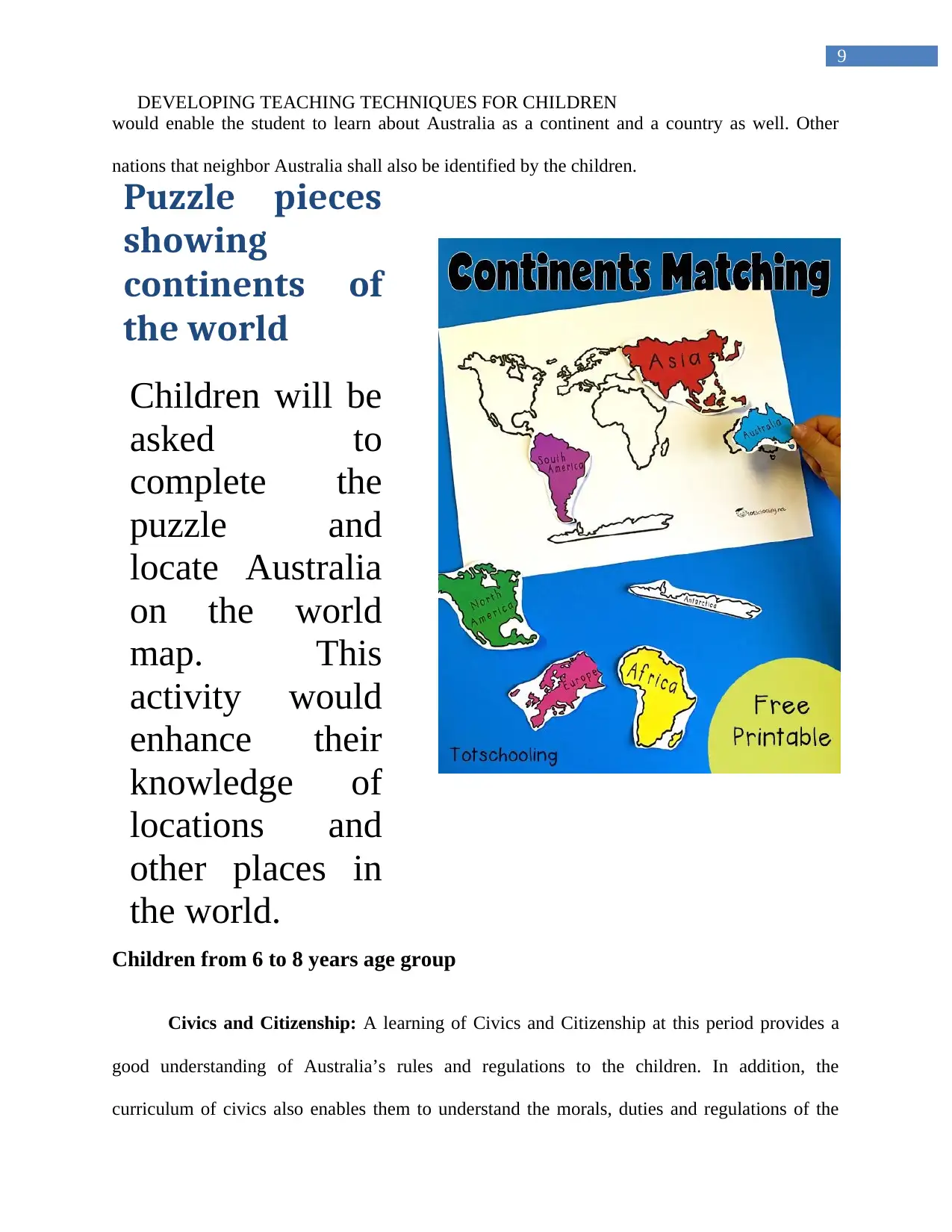
9
DEVELOPING TEACHING TECHNIQUES FOR CHILDREN
would enable the student to learn about Australia as a continent and a country as well. Other
nations that neighbor Australia shall also be identified by the children.
Children from 6 to 8 years age group
Civics and Citizenship: A learning of Civics and Citizenship at this period provides a
good understanding of Australia’s rules and regulations to the children. In addition, the
curriculum of civics also enables them to understand the morals, duties and regulations of the
Puzzle pieces
showing
continents of
the world
Children will be
asked to
complete the
puzzle and
locate Australia
on the world
map. This
activity would
enhance their
knowledge of
locations and
other places in
the world.
DEVELOPING TEACHING TECHNIQUES FOR CHILDREN
would enable the student to learn about Australia as a continent and a country as well. Other
nations that neighbor Australia shall also be identified by the children.
Children from 6 to 8 years age group
Civics and Citizenship: A learning of Civics and Citizenship at this period provides a
good understanding of Australia’s rules and regulations to the children. In addition, the
curriculum of civics also enables them to understand the morals, duties and regulations of the
Puzzle pieces
showing
continents of
the world
Children will be
asked to
complete the
puzzle and
locate Australia
on the world
map. This
activity would
enhance their
knowledge of
locations and
other places in
the world.
Paraphrase This Document
Need a fresh take? Get an instant paraphrase of this document with our AI Paraphraser
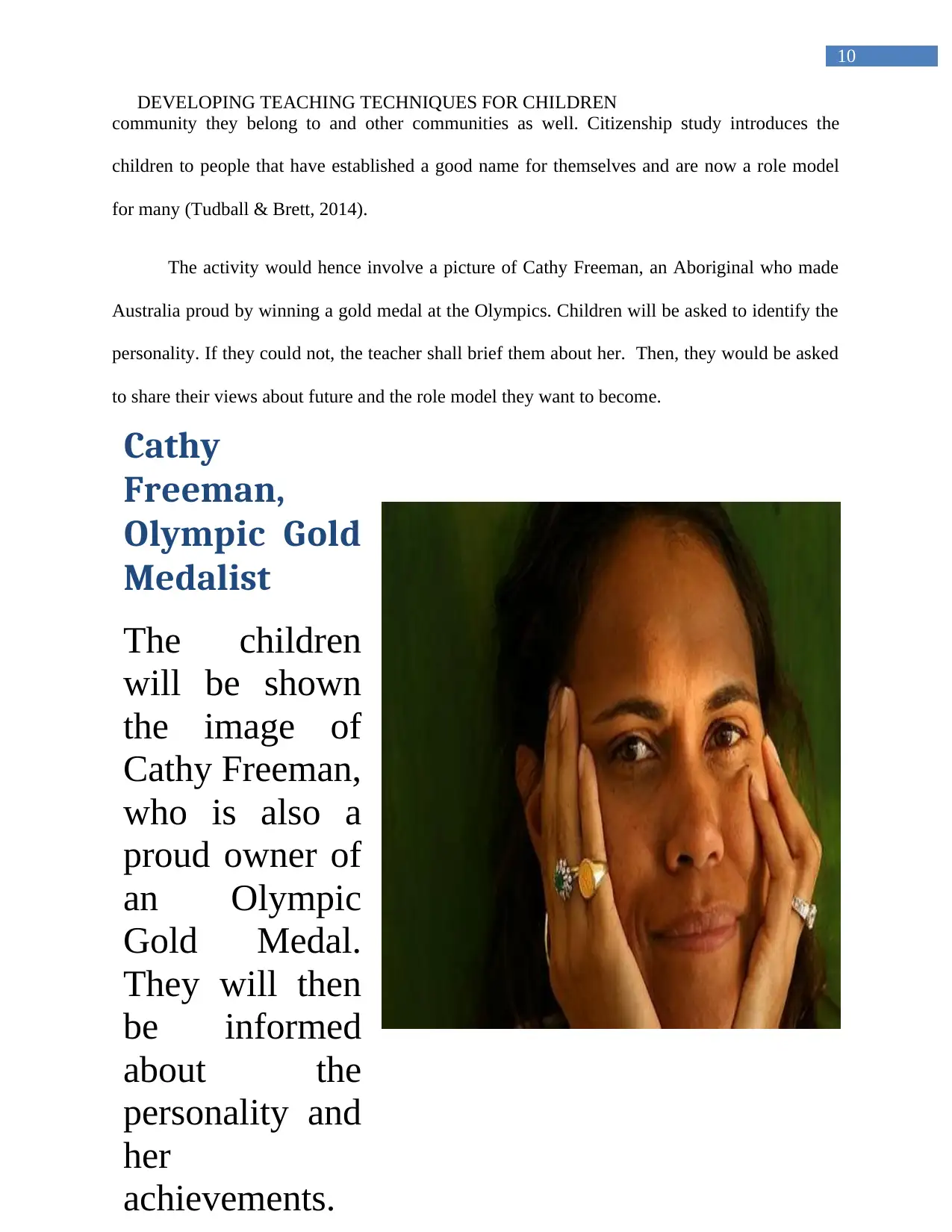
10
DEVELOPING TEACHING TECHNIQUES FOR CHILDREN
community they belong to and other communities as well. Citizenship study introduces the
children to people that have established a good name for themselves and are now a role model
for many (Tudball & Brett, 2014).
The activity would hence involve a picture of Cathy Freeman, an Aboriginal who made
Australia proud by winning a gold medal at the Olympics. Children will be asked to identify the
personality. If they could not, the teacher shall brief them about her. Then, they would be asked
to share their views about future and the role model they want to become.
Cathy
Freeman,
Olympic Gold
Medalist
The children
will be shown
the image of
Cathy Freeman,
who is also a
proud owner of
an Olympic
Gold Medal.
They will then
be informed
about the
personality and
her
achievements.
DEVELOPING TEACHING TECHNIQUES FOR CHILDREN
community they belong to and other communities as well. Citizenship study introduces the
children to people that have established a good name for themselves and are now a role model
for many (Tudball & Brett, 2014).
The activity would hence involve a picture of Cathy Freeman, an Aboriginal who made
Australia proud by winning a gold medal at the Olympics. Children will be asked to identify the
personality. If they could not, the teacher shall brief them about her. Then, they would be asked
to share their views about future and the role model they want to become.
Cathy
Freeman,
Olympic Gold
Medalist
The children
will be shown
the image of
Cathy Freeman,
who is also a
proud owner of
an Olympic
Gold Medal.
They will then
be informed
about the
personality and
her
achievements.
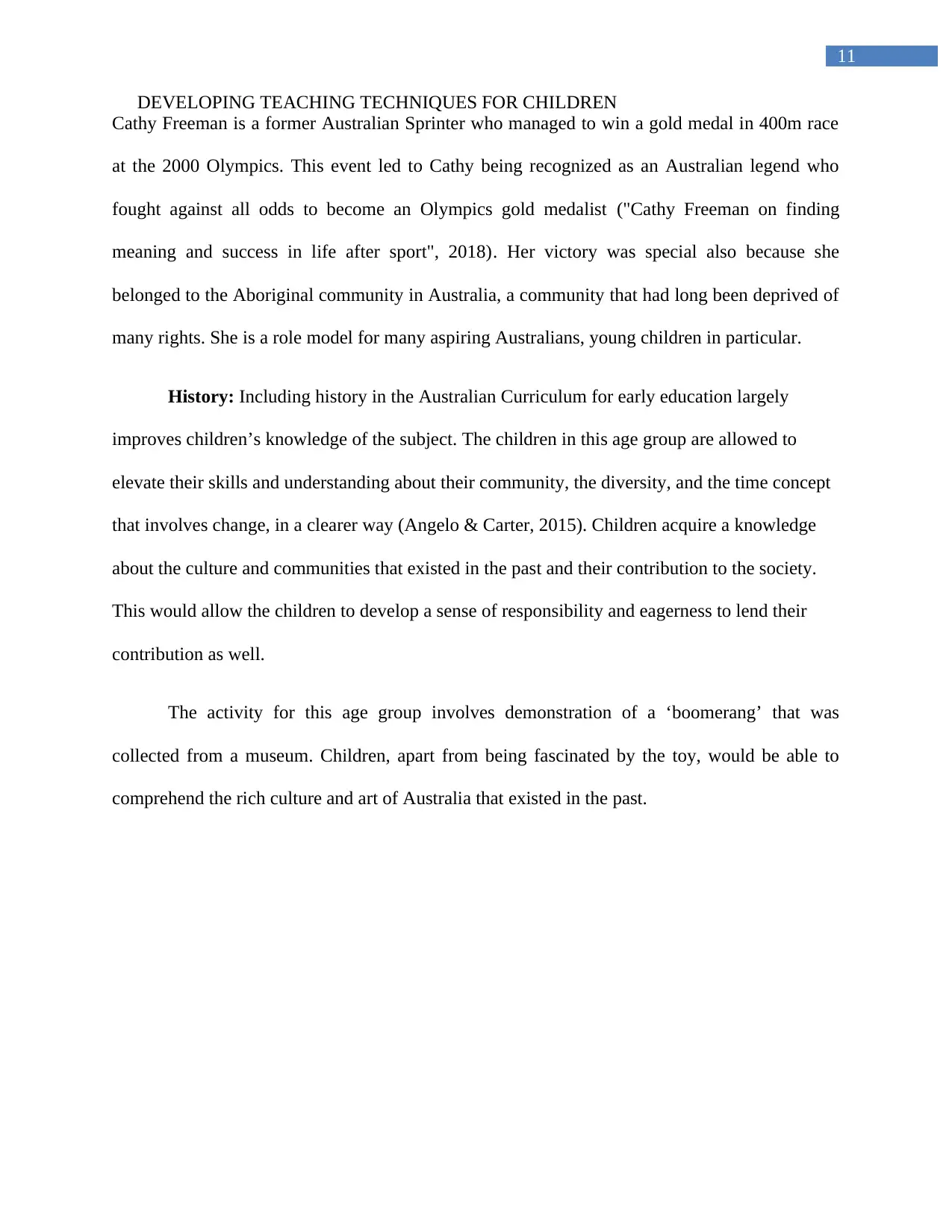
11
DEVELOPING TEACHING TECHNIQUES FOR CHILDREN
Cathy Freeman is a former Australian Sprinter who managed to win a gold medal in 400m race
at the 2000 Olympics. This event led to Cathy being recognized as an Australian legend who
fought against all odds to become an Olympics gold medalist ("Cathy Freeman on finding
meaning and success in life after sport", 2018). Her victory was special also because she
belonged to the Aboriginal community in Australia, a community that had long been deprived of
many rights. She is a role model for many aspiring Australians, young children in particular.
History: Including history in the Australian Curriculum for early education largely
improves children’s knowledge of the subject. The children in this age group are allowed to
elevate their skills and understanding about their community, the diversity, and the time concept
that involves change, in a clearer way (Angelo & Carter, 2015). Children acquire a knowledge
about the culture and communities that existed in the past and their contribution to the society.
This would allow the children to develop a sense of responsibility and eagerness to lend their
contribution as well.
The activity for this age group involves demonstration of a ‘boomerang’ that was
collected from a museum. Children, apart from being fascinated by the toy, would be able to
comprehend the rich culture and art of Australia that existed in the past.
DEVELOPING TEACHING TECHNIQUES FOR CHILDREN
Cathy Freeman is a former Australian Sprinter who managed to win a gold medal in 400m race
at the 2000 Olympics. This event led to Cathy being recognized as an Australian legend who
fought against all odds to become an Olympics gold medalist ("Cathy Freeman on finding
meaning and success in life after sport", 2018). Her victory was special also because she
belonged to the Aboriginal community in Australia, a community that had long been deprived of
many rights. She is a role model for many aspiring Australians, young children in particular.
History: Including history in the Australian Curriculum for early education largely
improves children’s knowledge of the subject. The children in this age group are allowed to
elevate their skills and understanding about their community, the diversity, and the time concept
that involves change, in a clearer way (Angelo & Carter, 2015). Children acquire a knowledge
about the culture and communities that existed in the past and their contribution to the society.
This would allow the children to develop a sense of responsibility and eagerness to lend their
contribution as well.
The activity for this age group involves demonstration of a ‘boomerang’ that was
collected from a museum. Children, apart from being fascinated by the toy, would be able to
comprehend the rich culture and art of Australia that existed in the past.
⊘ This is a preview!⊘
Do you want full access?
Subscribe today to unlock all pages.

Trusted by 1+ million students worldwide
1 out of 18
Related Documents
Your All-in-One AI-Powered Toolkit for Academic Success.
+13062052269
info@desklib.com
Available 24*7 on WhatsApp / Email
![[object Object]](/_next/static/media/star-bottom.7253800d.svg)
Unlock your academic potential
Copyright © 2020–2025 A2Z Services. All Rights Reserved. Developed and managed by ZUCOL.





